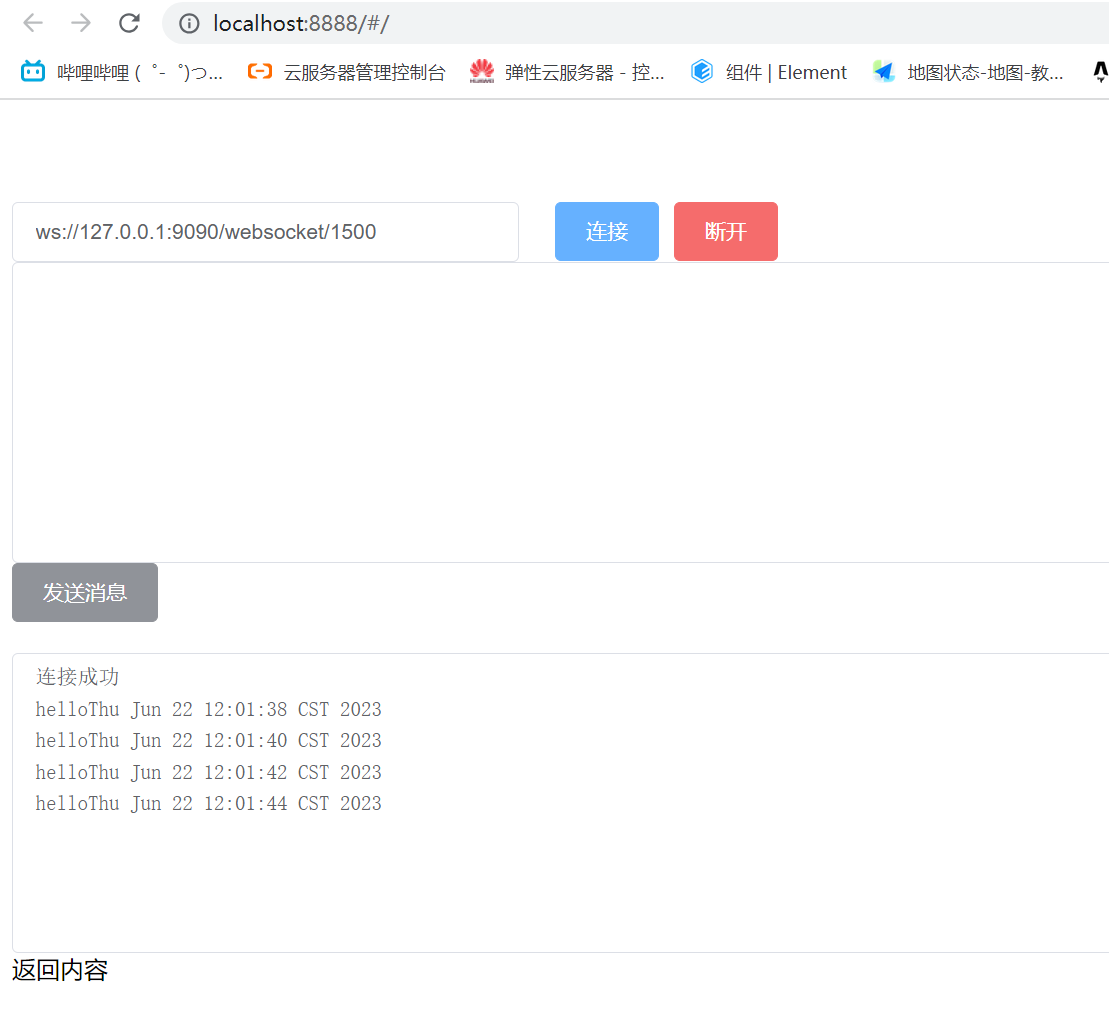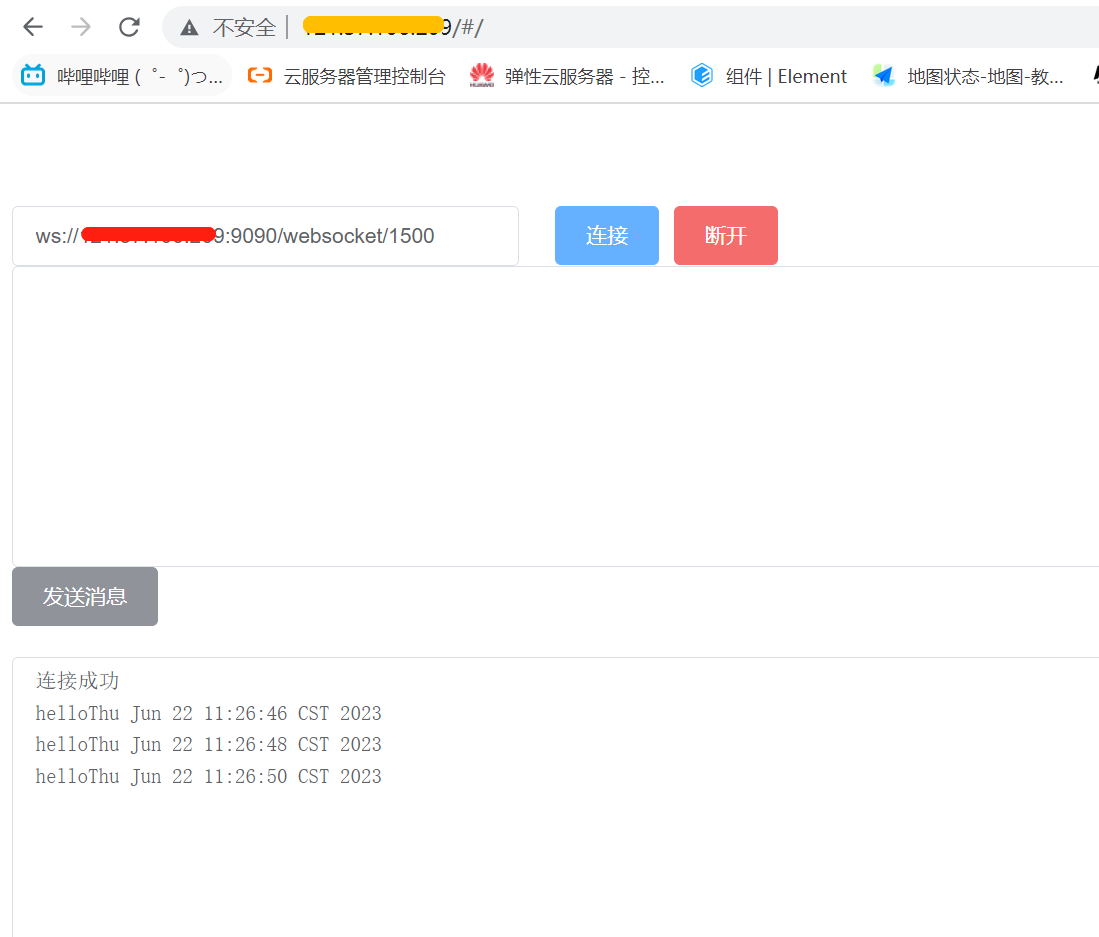前言:在最近的工作当中,客户反应需要实时接收消息提醒,这个功能虽然不大,但不过也用到了一些新的技术,于是我这边写一个关于我如何实现这个功能、编写、测试到部署服务器,归纳到这篇博客中进行总结。
一、什么是WebSocket
WebSocket是一种建立在TCP连接上的全双工通信协议,让客户端和服务端之间可以做到实时通信,允许服务端和客户端互相推送数据,服务端和客户端只要建立一次握手,两者之间便可以创建持久连接实现数据的双向传输。
二、后端实现
2.1、引入pom.xml依赖
<!-- 集成websocket实现实时通信 -->
<dependency>
<groupId>org.springframework.boot</groupId>
<artifactId>spring-boot-starter-websocket</artifactId>
</dependency>
<!-- 常用工具类 -->
<dependency>
<groupId>org.apache.commons</groupId>
<artifactId>commons-lang3</artifactId>
</dependency>
<!-- lombok -->
<dependency>
<groupId>org.projectlombok</groupId>
<artifactId>lombok</artifactId>
<version>1.18.26</version>
</dependency>
2.2、注册WebSocket核心配置类
package com.example.websocket.config;
import org.springframework.context.annotation.Bean;
import org.springframework.context.annotation.Configuration;
import org.springframework.web.socket.server.standard.ServerEndpointExporter;
@Configuration
public class WebSocketConfig
{
@Bean
public ServerEndpointExporter serverEndpointExporter()
{
return new ServerEndpointExporter();
}
}
2.3、编写WebSocket服务器核心代码
这里我提供两种,可以随意进行选择。
第一种:
package com.ithuang.websocket.config;
import lombok.extern.slf4j.Slf4j;
import org.apache.commons.lang3.StringUtils;
import org.springframework.stereotype.Component;
import javax.websocket.*;
import javax.websocket.server.PathParam;
import javax.websocket.server.ServerEndpoint;
import java.io.IOException;
import java.util.concurrent.ConcurrentHashMap;
@ServerEndpoint("/websocket/{userId}")
@Component
@Slf4j
public class WebSocketServer {
/**静态变量,用来记录当前在线连接数。应该把它设计成线程安全的。*/
private static int onlineCount = 0;
/**concurrent包的线程安全Set,用来存放每个客户端对应的MyWebSocket对象。*/
private static ConcurrentHashMap<String,WebSocketServer> webSocketMap = new ConcurrentHashMap<>();
/**与某个客户端的连接会话,需要通过它来给客户端发送数据*/
private Session session;
/**接收userId*/
private String userId="";
/**
* 连接建立成功调用的方法*/
@OnOpen
public void onOpen(Session session, @PathParam("userId") String userId) {
this.session = session;
this.userId=userId;
if(webSocketMap.containsKey(userId)){
webSocketMap.remove(userId);
webSocketMap.put(userId,this);
//加入set中
}else{
webSocketMap.put(userId,this);
//加入set中
addOnlineCount();
//在线数加1
}
log.info("用户连接:"+userId+",当前在线人数为:" + getOnlineCount());
try {
sendMessage("连接成功");
} catch (IOException e) {
log.error("用户:"+userId+",网络异常!!!!!!");
}
}
/**
* 连接关闭调用的方法
*/
@OnClose
public void onClose() {
if(webSocketMap.containsKey(userId)){
webSocketMap.remove(userId);
//从set中删除
subOnlineCount();
}
log.info("用户退出:"+userId+",当前在线人数为:" + getOnlineCount());
}
/**
* 收到客户端消息后调用的方法
*
* @param message 客户端发送过来的消息*/
@OnMessage
public void onMessage(String message, Session session) {
log.info("用户消息:"+userId+",报文:"+message);
//可以群发消息
//消息保存到数据库、redis
// if(StringUtils.isNotBlank(message)){
// try {
// //解析发送的报文
// JSONObject jsonObject = JSON.parseObject(message);
//
// }catch (Exception e){
// e.printStackTrace();
// }
// }
}
/**
*
* @param session
* @param error
*/
@OnError
public void onError(Session session, Throwable error) {
log.error("用户错误:"+this.userId+",原因:"+error.getMessage());
}
/**
* 实现服务器主动推送
*/
public void sendMessage(String message) throws IOException {
this.session.getBasicRemote().sendText(message);
}
/**
* 实现服务器主动推送
*/
public void sendAllMessage(String message) throws IOException {
ConcurrentHashMap.KeySetView<String, WebSocketServer> userIds = webSocketMap.keySet();
for (String userId : userIds) {
WebSocketServer webSocketServer = webSocketMap.get(userId);
webSocketServer.session.getBasicRemote().sendText(message);
}
}
/**
* 发送自定义消息
* */
public static void sendInfo(String message,@PathParam("userId") String userId) throws IOException {
log.info("发送消息到:"+userId+",报文:"+message);
if(StringUtils.isNotBlank(userId)&&webSocketMap.containsKey(userId)){
webSocketMap.get(userId).sendMessage(message);
}else{
log.error("用户"+userId+",不在线!");
}
}
public static synchronized int getOnlineCount() {
return onlineCount;
}
public static synchronized void addOnlineCount() {
WebSocketServer.onlineCount++;
}
public static synchronized void subOnlineCount() {
WebSocketServer.onlineCount--;
}
}
第二种:
package com.ithuang.websocket.config;
import lombok.extern.slf4j.Slf4j;
import org.springframework.stereotype.Component;
import javax.websocket.*;
import javax.websocket.server.PathParam;
import javax.websocket.server.ServerEndpoint;
import java.io.IOException;
import java.util.concurrent.ConcurrentHashMap;
import java.util.concurrent.CopyOnWriteArraySet;
@ServerEndpoint("/websocket/{userId}")
@Component
@Slf4j
public class WebSocketServer {
// 与某个客户端的连接会话,需要通过它来给客户端发送数据
private Session session;
// session集合,存放对应的session
private static ConcurrentHashMap<Integer, Session> sessionPool = new ConcurrentHashMap<>();
// concurrent包的线程安全Set,用来存放每个客户端对应的WebSocket对象。
private static CopyOnWriteArraySet<WebSocketServer> webSocketSet = new CopyOnWriteArraySet<>();
/**
* 建立WebSocket连接
*
* @param session
* @param userId 用户ID
*/
@OnOpen
public void onOpen(Session session, @PathParam(value = "userId") Integer userId) {
log.info("WebSocket建立连接中,连接用户ID:{}", userId);
try {
Session historySession = sessionPool.get(userId);
// historySession不为空,说明已经有人登陆账号,应该删除登陆的WebSocket对象
if (historySession != null) {
webSocketSet.remove(historySession);
historySession.close();
}
} catch (IOException e) {
log.error("重复登录异常,错误信息:" + e.getMessage(), e);
}
// 建立连接
this.session = session;
webSocketSet.add(this);
sessionPool.put(userId, session);
log.info("建立连接完成,当前在线人数为:{}", webSocketSet.size());
}
/**
* 发生错误
*
* @param throwable e
*/
@OnError
public void onError(Throwable throwable) {
throwable.printStackTrace();
}
/**
* 连接关闭
*/
@OnClose
public void onClose() {
webSocketSet.remove(this);
log.info("连接断开,当前在线人数为:{}", webSocketSet.size());
}
/**
* 接收客户端消息
*
* @param message 接收的消息
*/
@OnMessage
public void onMessage(String message) {
log.info("收到客户端发来的消息:{}", message);
}
/**
* 推送消息到指定用户
*
* @param userId 用户ID
* @param message 发送的消息
*/
public static void sendMessageByUser(Integer userId, String message) {
log.info("用户ID:" + userId + ",推送内容:" + message);
Session session = sessionPool.get(userId);
try {
session.getBasicRemote().sendText(message);
} catch (IOException e) {
log.error("推送消息到指定用户发生错误:" + e.getMessage(), e);
}
}
/**
* 群发消息
*
* @param message 发送的消息
*/
public static void sendAllMessage(String message) {
log.info("发送消息:{}", message);
for (WebSocketServer webSocket : webSocketSet) {
try {
webSocket.session.getBasicRemote().sendText(message);
} catch (IOException e) {
log.error("群发消息发生错误:" + e.getMessage(), e);
}
}
}
}
4、撰写定时任务
注:主启动类需要加上@EnableScheduling,否则不生效。
package com.ithuang.websocket.task;
import com.ithuang.websocket.config.WebSocketServer;
import org.springframework.scheduling.annotation.Scheduled;
import org.springframework.stereotype.Component;
import javax.annotation.Resource;
import java.io.IOException;
import java.util.Date;
@Component
public class Send {
@Resource
private WebSocketServer webSocketServer;
@Scheduled(fixedDelay = 2000)
public void sendMsg() throws IOException {
webSocketServer.sendAllMessage("hello"+new Date());
}
}
三、前端实现
需要先自行安装好element-ui组件库,这边不做演示,直接贴出代码
<template>
<div>
<template>
<div>
<el-input v-model="url" type="text" style="width: 20%" />
<el-button @click="initWebsocket" type="primary">连接</el-button>
<el-button @click="exit" type="danger">断开</el-button>
<br />
<el-input type="textarea" v-model="message" :rows="9" />
<el-button type="info" @click="send">发送消息</el-button>
<br />
<br />
<el-input type="textarea" v-model="text_content" :rows="9" /> 返回内容
<br />
<br />
</div>
</template>
</div>
</template>
<script>
// @ is an alias to /src
import HelloWorld from '@/components/HelloWorld.vue'
export default {
name: 'HomeView',
components: {
HelloWorld
},
data() {
return {
url: "ws://127.0.0.1:9090/websocket/1500",
message: "",
text_content: "",
ws: null,
};
},
created() {
},
destroyed() {
this.exit()
},
methods:{
initWebsocket(){
this.ws = new WebSocket(this.url);
const self = this;
this.ws.onopen = function (event) {
// self.text_content = self.text_content + "已经打开连接!" + "\n";
};
this.ws.onmessage = function (event) {
self.text_content = self.text_content + event.data +"\n";
};
this.ws.onclose = function (event) {
// self.text_content = self.text_content + "已经关闭连接!" + "\n";
};
},
exit() {
if (this.ws) {
this.ws.close();
this.ws = null;
}
},
send() {
if (this.ws) {
this.ws.send(this.message);
} else {
alert("未连接到服务器");
}
},
}
}
</script>
四、本地测试
点击连接

当点击断开或者关闭浏览器,后台输出如下
五、打包前后端
具体的打包方式这边不再做阐述,在后端打包可能会出现如下异常:
解决如下:
在单元测试类上面加上此注解:
@SpringBootTest(webEnvironment = SpringBootTest.WebEnvironment.RANDOM_PORT)
六、部署到服务器测试
具体的部署流程这边不再贴出,把默认的127.0.0.1替换成自己的服务器IP,点击连接即可,后端就会每2秒推送一次消息了,看代码结果。
部署的前端端口默认是80,后端端口是9090,记得放行端口。

后台日志如下: 
七、Gitee源码
前端代码:vue-websocket: vue实现websocket连接的前端代码
后端代码:springboot-websocket: springboot后端实现websocket连接源码
版权归原作者 黄团团 所有, 如有侵权,请联系我们删除。